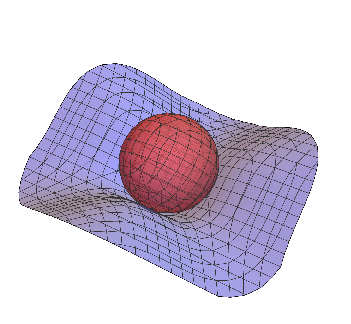Chain Fibrations And Their Cyclic Potential
Published:
It is not hard to imagine a chain of fibrations,
\[E_n \stackrel{p_n}{\longrightarrow}E_{n-1}\stackrel{p_{n-1}}{\longrightarrow}...\stackrel{p_{2}}{\longrightarrow}E_1\stackrel{p_1}{\longrightarrow}B\]but the concept becomes more interesting when one requires $E_n=B$. Are there any scenarios in which this is realized? Can they be classified? These questions are the motivation for the present post and what follows are a few different variations and examples.
I. The answer to the first question is clearly yes. The following chain is one such example
\[S^1\stackrel{p_n}{\longrightarrow} ... \stackrel{p_1}{\longrightarrow}S^1\]where $p_i: z\mapsto z^{m_i}$ for some $m_i\in \mathbb{Z}$. The classification of all such $S^1$ chains would begin by indentifying them with the sequences $(m_1,…,m_n)$. This example could easily be generalized by allowing for the maps $p_i$ to be arbitrary coverings $S^1\to S^1$. All such coverings are easily classified up to homeomorphism by the positive integers corresponding to the winding number.
While the above example allows us to conclude that such chains exist, it is heavily restricting in the character of the fibers. Is there any cyclic chain with continuous fibers? Suppose there is and for simplicity suppose it contains only two topological spaces:
\[B\stackrel{p}{\longrightarrow}E\stackrel{f}{\longrightarrow}B\]this tells us that $E$ is parameterizing continuous fibers in $B$ while $B$ is doing the same to $E$. If there is a dimensional component to $B$ and $E$ then there surely cannot be such an $f$. However, in a more general topological setting, perhaps this is attainable. It is worth noting two related structures. The first is the fibration \(E\stackrel{p}{\longrightarrow}B\hookrightarrow E\times B\stackrel{\pi}{\longrightarrow}E\) while the second is the interpretation of $E\stackrel{p}{\longrightarrow}B\stackrel{f}{\longrightarrow}E$ as a short exact sequence (in some category where objects are unital). This latter example gives a fibration of $E$ over $B$ with fibers homeomorphic to $B$ itself.
II. As another consideration, let us now turn to principal bundles. If we have a lie group $G$ and a chain of compact normal subgroups $H_1 < H_2 < … < H_n < G$, we can generate a nice chain of principle bundles:
\[G\stackrel{p_1}{\longrightarrow}G/H_1\stackrel{p_{2}}{\longrightarrow}...\stackrel{p_{n}}{\longrightarrow}G/H_n\]where $(G/H_i,G/H_{i+1},p_i)$ is a principal $[H_{i+1}]_{G/H_i}-$bundle ($[\hspace{.5em}]_X$ denotes the equivalency class in $X$). However interesting this chain may be, it seems to have no “cyclic potential” because we cannot simply replace $G$ with $G/H_n$.
An interesting variation on this is to ask if there is a map $p: G\to G$ which could be interpreted as a principle $H-$bundle for some $H\subset G$? The answer is probably no for the same reason that (3) seems to fail. The fibers must be homeomorphic to $H$ which would mean $G$ is homeomorphic to $H\times G$ if the fibration is trivial. Nothing should change if we pass to the locally trivial setting because we would have an analogous problem where for every element $g\in G$ there must be a neighborhood $U_g$ such that $p^{-1}(U_g)\cong U_g \times H$ which would make no sense if $p^{-1}(U_g),U_g \subset G$. Can this dream be saved if we set $G$ to be infinite-dimensional? Perhaps, but the author currently has no experience with such objects.
A similar concept is a structure in which the base space and the group are the same object, i.e., we have $p: E\to G$ defining a principle $G-$bundle. One initial attempt to realize this would be to get $S^2$ to act on $S^3$ preserving the fibers of the Hopf map, but $S^2$ cannot be realized as a lie group so this fails. In general, the fibers of this bundle must be homeomorphic to $G$, by free and trnasitive $G-$action, so $E$ is homeomorphic to $G\times G$ or some twisted variation. Is there a good classification of all $G-$bundles over $G$?
One can pass to the infinite-dimensional setting and consider the space of continuously differentiable functions, $C^\infty$, over some manifold $M$. Is there a subspace $H\subset C^\infty$ and a space of differential operators parameterized by $H$, $(L_\psi: C^\infty \to C^\infty)_{\psi\in H}$, such that the moduli spaces form a fibration?
\[L: C^\infty \to H\] \[L: \phi \mapsto \psi \iff L_\psi(\phi) = 0\]Further, is there some function action under which this bundle can be interpreted as principal? Perhaps convolution with $H$ could admit a principal $H-$bundle structure. What about under some other action like the push forward (denoted #):
This action is quite interesting and is crucial in the study of gradient flow. It seems reasonable to think that this action could admit orbits with free action ready to be used as fibers, but to show this and to get insight into its cyclic potential, a much deeper investigation is required.
I encourage readers to email any thoughts or additional resources they might have.
